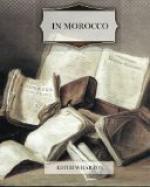Central Laboratory at Rabat. This is a kind of Pasteur Institute. In 1917, 210,000 persons were vaccinated throughout the country and 356 patients treated at the Laboratory for rabies.
Clinics for venereal diseases have been established at Casablanca, Fez, Rabat, and Marrakech.
More than 15,000 cases were treated in 1917.
Ophthalmic clinics in the same cities gave in 1917, 44,600 consultations.
Radiotherapy. Clinics have been opened at Fez and Rabat for the treatment of skin diseases of the head, from which the native children habitually suffer.
The French Department of Health distributes annually immense quantities of quinine in the malarial districts.
Madame Lyautey’s private charities comprise admirably administered child-welfare centres in the principal cities, with dispensaries for the native mothers and children.
VII
A SKETCH OF MOROCCAN HISTORY
[NOTE—In the chapters on Moroccan history and art I have tried to set down a slight and superficial outline of a large and confused subject. In extenuation of this summary attempt I hasten to explain that its chief merit is its lack of originality.
Its facts are chiefly drawn from the books mentioned in the short bibliography at the end of the volume, in addition to which I am deeply indebted for information given on the spot to the group of remarkable specialists attached to the French administration, and to the cultivated and cordial French officials, military and civilian, who, at each stage of my rapid journey, did their best to answer my questions and open my eyes.]
I
THE BERBERS
In the briefest survey of the Moroccan past, account must first of all be taken of the factor which, from the beginning of recorded events, has conditioned the whole history of North Africa: the existence, from the Sahara to the Mediterranean, of a mysterious irreducible indigenous race with which every successive foreign rule, from Carthage to France, has had to reckon, and which has but imperfectly and partially assimilated the language, the religion, and the culture that successive civilizations have tried to impose upon it.
This race, the race of Berbers, has never, modern explorers tell us, become really Islamite, any more than it ever really became Phenician, Roman or Vandal. It has imposed its habits while it appeared to adopt those of its invaders, and has perpetually represented, outside the Ismalitic and Hispano-Arabic circle of the Makhzen, the vast tormenting element of the dissident, the rebellious, the unsubdued tribes of the Blad-es-Siba.
Who were these indigenous tribes with whom the Phenicians, when they founded their first counting-houses on the north and west coast of Africa, exchanged stuffs and pottery and arms for ivory, ostrich-feathers and slaves?




